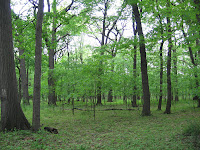Des Plaines River Journal: My good fortune

(POSTED: 9/10/09) It is my good fortune to live very near the Des Plaines River in Park Ridge. From my living room in the northwest suburb, I may view through the seasons a wooded area of the Cook County Forest Preserve verging on the river. In early morning and evening twilight, deer (I've counted as many as 14 at a time) graze gently in a field near my condominium building. Deeper into the woods, I've also seen coyote, a fox, beaver signs, chipmunks, squirrels, as well as ducks and Canada geese that sometimes land on the river, swooping in -- like the planes at nearby O’Hare Field -- for graceful landings.
From ancient times until the industrial age, this river served as an important means of transportation, strategically merging its waters with those of the Kankakee River near Joliet. There, the two rivers become the Illinois River that flows into the Mississippi. Thus, a voyageur of olden times could journey without portage from the source of the Des Plaines, near Kenosha, to the Gulf of Mexico.
Just as importantly, those travelers willing to make a portage from the Des Plaines to the northern or southern branches of the Chicago River could access Lake Michigan, and the northern worlds to which it could take them. Touhy Avenue, near where I live, was a popular portage trail, extending from the Des Plaines River (near where the Tri-State Tollway passes) to the North Branch of the Chicago River near Caldwell Avenue.

Today, however, the Des Plaines seems not used much for anything other than recreational transportation, mainly canoeing in the northern sections of the river, and fishing boats on its southern, larger stretches near Joliet. Pollution levels, sadly, run rather high in the river, and I have never gone swimming in it. For me, it is mainly the pleasures of walking, and sometimes jogging or cross-country skiing, near the river that draw me and others to the foot paths that wind along it banks. It is also the pleasure of occasionally chatting with fellow walkers, sometimes for only a short time, that draws me.
In the years that I've walked the trails near my home, I've met a variety of folks at all times of years. We seem a congenial lot, at least while on the trails, perhaps calmed or grounded by nearness to the natural world. In a large field surrounded by forest south of Devon Avenue, a Boy Scout camp used to stand, and I recently I struck up conversation with a man and his metal-detector. "I am looking," he explained, "for old coins, left by the scouts way back when." He showed me a few that he'd found, dating from the early 1900s, so we guessed that "way back when" was likely the 1930s and '40s.
Earlier this summer, as I enjoyed lunch at a picnic table near my home, I observed two women picking leaves from large, verdant bushes on the edge of the preserve. Eventually I wandered over to them, asking what it was they were picking. They showed me bunches of green leaves they were transferring to plastic shopping bags, but, since English was apparently not their first language, they could not tell me what sort of leaf it was. Later in the day, after they had gone, I returned to the spot, picked from the plants and felt like I had been stung by a bee. "Ah, stinging nettles," I surmised, and recalled that I had seen, but not noted sufficiently, the gloves the women had worn as they went about their work. After some ice on the hand, a bit of Googling revealed that my identification was correct, and that stinging nettles, when handled and properly prepared, may be used for healthful teas, and work specifically as an astringent or anti-inflammatory treatment.
Another poignant encounter I recall was with a lady walking beside a miniature dog on a leash. The little dog curiously trotted in a small circle at the end of its leash. Endlessly. The dog, seemingly locked into a small orbit, looked only at the ground as it traced its inevitable route. "I obtained him," the lady said, "from a dog rescue shelter, where they explained to me that this dog had been abused. He was locked into a little box for over a year, and all it knows to do is walk in the small circle that a capture box would permit. I'm hoping that bringing him out into the woods, into these open spaces, will help him to recover."
I was stunned by the story, and impressed both by the cruelty of the previous owner and the devotion of the current owner.
I could only hope that walks in the woods would bring to that dog the healing and straightening that many of us find here.
By Jeff Wagner
Jeffrey Wagner, a graduate of Northwestern University and Indiana University, is a Chicago-area musician and writer who has published numerous articles in Clavier Magazine, and other journals. Since boyhood, he has loved the outdoors, and has hiked, camped and back-packed all over the United States.
Contact: [email protected] or [email protected]


0 comments: